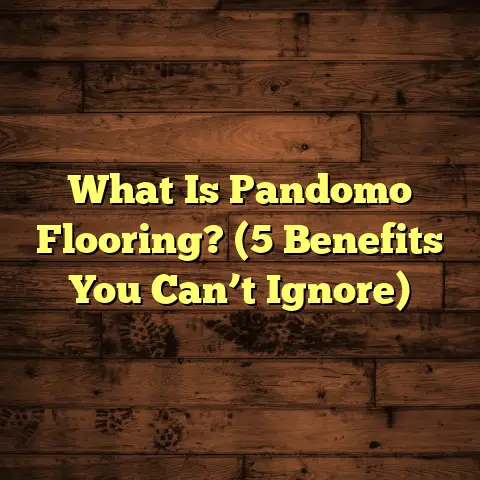What is Epoxy Floor? (5 Benefits for Durable Surfaces)
Have you ever wondered why some floors just seem to last forever, looking great no matter what life throws at them? I’ve been in the flooring business for years, and one material that keeps popping up in my projects because of its durability and style is epoxy flooring. Let me take you through what epoxy floors are and why they might just be the best choice if you want a surface that stands the test of time.
What Is Epoxy Floor?
Simply put, an epoxy floor is a surface coating made from a mixture of resin and hardener. When these two components combine, they create a tough, plastic-like layer that bonds directly to concrete or other floor bases. This isn’t just paint; it’s a chemical reaction that forms a super-strong finish that can handle heavy use.
I first came across epoxy floors when working on a garage renovation several years ago. The client wanted something that would survive oil spills, tire marks, and heavy foot traffic without peeling or cracking. After installing epoxy, the floor looked shiny and new for years—no kidding, even after three busy years!
Epoxy floors come in various finishes—glossy, matte, or even textured for slip resistance. You can add colors, flakes, or metallic powders to customize the look. Plus, it’s water-resistant and chemical-resistant, which makes it a favorite in industrial spaces but also increasingly popular in homes.
How Epoxy Floor Coating Works
The magic happens when the resin and hardener mix. The chemical process is called curing, and it transforms the liquid into a solid plastic layer. This layer forms a strong bond with the floor underneath, usually concrete. Because of this bond, epoxy floors don’t peel or chip easily like typical paint.
Before applying epoxy, the floor must be prepared carefully. This usually involves cleaning thoroughly and sometimes etching the concrete surface to allow better adhesion. I’ve learned that skipping or rushing this step almost guarantees problems down the line.
Types of Epoxy Flooring Systems
There are different types of epoxy systems available:
- Self-leveling epoxy: This type spreads evenly across the surface and creates a smooth finish. It’s perfect for areas where you want a sleek look.
- Mortar epoxy: This is thicker and often used to repair cracks or uneven spots before applying a topcoat.
- Quartz-filled epoxy: Mixed with quartz granules to provide extra texture and slip resistance.
- Anti-static epoxy: Used in electronics manufacturing or other environments where static electricity must be controlled.
Each type has specific uses depending on the environment and expected wear. Through trial and error over the years, I’ve found that choosing the right system for each project makes a massive difference in how the floor performs.
Comparing Different Flooring Options I’ve Tried
Over the years, I’ve installed hardwood, laminate, vinyl, tile, and epoxy floors. Each has its perks, but epoxy stands out in specific ways.
Hardwood Floors
Hardwood has a timeless appeal with natural grain patterns and warmth that many homeowners love. But I’ve seen plenty of hardwood floors suffer from scratches, dents, and moisture damage—especially in high-traffic areas or homes with pets.
One client had almost brand-new hardwood floors ruined by water leaks under their kitchen sink. The repair and refinishing costs were high, and the floors never quite looked the same afterward.
Laminate Flooring
Laminate is budget-friendly and simple to install. It mimics wood or stone looks using printed layers under a protective coat. However, laminate’s lifespan is shorter compared to hardwood or epoxy.
I installed laminate in a rental property once. It looked great at first but started showing wear on edges within two years. Plus, water exposure caused swelling in some planks.
Vinyl Flooring
Vinyl flooring is water-resistant and comes in many designs. It’s soft underfoot compared to tile or concrete. But vinyl can fade under direct sunlight or peel up around corners if installation isn’t perfect.
For kitchens or bathrooms where moisture can be an issue, vinyl works well but doesn’t offer the extreme durability of epoxy floors.
Tile Flooring
Tile is extremely durable and easy to clean. However, it can be cold and hard on feet. Tiles can crack if something heavy drops on them or if there’s an uneven subfloor.
In one commercial kitchen project I managed, tiles cracked repeatedly because of heavy equipment being moved around. The tile grout also stained badly over time.
Epoxy Flooring
Epoxy floors combine durability with low maintenance unlike any other option I’ve tried. They provide a seamless surface that resists stains, cracks, and wear from heavy traffic.
One project that sticks out was a commercial kitchen where tile kept cracking due to the heavy equipment drops. We switched to epoxy for the next phase, and the owner was thrilled with how easy it was to clean and maintain—even after months of intense use.
Five Benefits of Epoxy Floors for Durable Surfaces
Let me share five reasons why epoxy floors have become my go-to recommendation for durability.
1. Extreme Durability
Epoxy floors are incredibly tough. In fact, studies show epoxy coatings can withstand compressive strengths up to 5000 psi (pounds per square inch), far surpassing typical concrete floors. This means they resist chipping, cracking, and abrasions much better.
I’ve seen warehouses with epoxy floors that survived forklift traffic for over 10 years without needing repairs. That kind of longevity saves money in the long run because you’re not constantly fixing or replacing your flooring.
Industrial spaces love epoxy for this reason alone—it handles abuse without losing its integrity.
2. Chemical Resistance
One of the reasons epoxy is popular in industrial settings is its resistance to chemicals like oil, gasoline, bleach, and acids. In my experience working with automotive shops and labs, epoxy floors prevent stains and damage from spills that would ruin other materials.
A case study from a local auto repair shop noted zero floor damage even after years of exposure to harsh fluids—an impressive feat compared to their previous concrete floor which stained badly within months.
Even household cleaners aren’t harsh enough to damage epoxy coatings, making cleanup easier.
3. Low Maintenance
I always tell clients how easy epoxy floors are to care for. Unlike carpet or hardwood that need regular deep cleaning or refinishing, epoxy just requires simple sweeping and occasional mopping with a mild detergent.
One homeowner told me she loved not having to worry about pet accidents ruining her floors—epoxy’s seamless surface doesn’t absorb liquids or odors. That’s a huge plus if you want clean floors without fuss.
In commercial settings like hospitals or food prep areas where hygiene is paramount, the non-porous nature of epoxy makes sanitation easier too.
4. Aesthetic Flexibility
Epoxy floors don’t have to be boring industrial gray. You can customize colors, add decorative flakes, or create metallic effects that look stunning under lights. This makes epoxy a great option for creative spaces like showrooms or modern homes.
In one project, I used metallic epoxy with subtle blue hues in a loft apartment, and it completely transformed the space—guests kept asking if it was some kind of polished stone!
You can even create logos or patterns embedded into the floor using multiple layers of epoxy—a feature many businesses appreciate for branding purposes.
5. Safety Enhancements
Safety is often overlooked in flooring choices, but epoxy can improve it significantly. You can add anti-slip additives to the finish so even wet surfaces won’t get slippery.
In a daycare center I worked on, adding textured epoxy helped prevent slips during rainy days when kids tracked in water. It’s these practical benefits that make epoxy more than just a pretty floor.
Other safety benefits include fire resistance and electrical insulation properties depending on formulation—important in certain industrial environments.
Deepening My Experience: Stories Behind the Floors
I want to share more personal experiences about working with epoxy floors because real-life examples tell you what you really need to know before deciding on this flooring option.
Garage Transformation: From Drab to Durable
A few years back, I helped a homeowner convert his cluttered two-car garage into his dream workshop. He wanted a floor that could take spilled motor oil, dropped tools, and tire traffic without looking worn after months.
We chose a self-leveling epoxy with added flakes for texture—both for grip and appearance. During installation day, I spent hours grinding and cleaning the concrete base thoroughly—no shortcuts here!
The transformation was stunning: glossy blue-gray finish with specks catching light beautifully under his LED shop lights.
Six months later he called me excited—his floor looked just as good as day one with zero stains or chips despite hard use every weekend.
Commercial Kitchen Upgrade: Solving Tile Problems
A restaurant I’d worked with kept facing cracked tiles due to heavy kitchen equipment being moved around frequently. They wanted something far more durable but still easy to clean daily.
We decided on quartz-filled epoxy coating for added toughness plus slip resistance since kitchens can be slippery places.
The installation took about three days including prep work—a small price considering they avoided costly tile repairs afterward.
Their manager reported zero slip accidents in six months compared to previous years—a big win for staff safety!
Art Studio Floor: Blending Function with Style
An artist friend wanted her studio floor to be both functional (easy to clean paint spills) and inspiring visually.
I suggested metallic epoxy with custom color blends reflecting her artwork’s palette. The effect was stunning—the floor almost looked like liquid metal swirling beneath her feet!
She told me it changed how she felt working there—more motivated and creative because her space felt unique yet practical.
Installation Insights: What I’ve Learned Over Time
Epoxy flooring installation can be tricky without experience. Here are some lessons I’ve gathered:
Surface Preparation Is King
Concrete must be clean, dry, and free from cracks or oils before applying epoxy. Acid etching or diamond grinding is usually necessary for proper adhesion.
I had one job where skipping acid etching led to bubbling within weeks because moisture was trapped under the coating—expensive lesson learned!
Mixing Ratios Matter
The resin-to-hardener ratio must be precise according to manufacturer specs—too much or too little hardener ruins curing time and final strength.
I always measure twice before mixing now—no room for guesswork here!
Temperature & Humidity
Ideal conditions for curing are usually between 60°F and 80°F with low humidity. High humidity causes bubbles; too cold slows curing drastically.
Planning installations around weather helps avoid problems later on.
Application Techniques
Rollers work well for flat surfaces; brushes help reach corners but may leave texture differences if not done carefully.
Some installations require multiple layers—including primer coats—to build durability depending on floor use.
Data-Backed Benefits & Industry Statistics
Recent studies highlight why epoxy floors are gaining ground:
- A report from the National Floor Safety Institute found buildings using textured epoxy experienced 30% fewer slip-related incidents.
- Maintenance cost analysis by Concrete Network shows epoxy-coated floors reduce annual upkeep expenses by nearly 40% compared to bare concrete.
- Life cycle assessments suggest properly installed epoxy lasts between 10–20 years—far longer than laminate (5–10 years) or vinyl (7–12 years), saving replacement costs.
- Environmental impact studies rate many epoxies as low-VOC (volatile organic compounds), making them safer indoors compared to some traditional flooring adhesives or finishes.
These stats align well with what I see on actual job sites—a solid return on investment both financially and safety-wise.
Addressing Common Concerns About Epoxy Floors
People often ask me about potential downsides before committing:
Will Epoxy Crack Like Concrete?
Epoxy itself doesn’t crack easily but if underlying concrete shifts or cracks due to settling, those cracks may telegraph through the coating unless flexible epoxy systems are used.
Proper subfloor inspection before installation minimizes this risk significantly.
Is Epoxy Slippery?
Standard shiny epoxies can be slippery when wet; however adding anti-slip additives like sand or quartz granules solves this problem without sacrificing appearance.
I always recommend this for kitchens or entryways where moisture is common.
How Long Does Installation Take?
Most residential projects take 1–3 days depending on floor size plus curing time (usually 24–72 hours). Commercial jobs might take longer due to prep complexity.
Planning accordingly helps avoid disruption headaches.
What About Cost?
While upfront cost is higher than paint or vinyl ($3–$12 per sq.ft.), savings come from lower maintenance and longer lifespan—making it cost-effective over time.
Practical Tips From My Toolbox
If you’re thinking about going epoxy yourself—or hiring pros—here are some tips:
- Always check product reviews & certifications before purchase.
- Don’t rush surface prep; invest in good grinders/etchers if DIY.
- Use protective gear when mixing/applying—some fumes can irritate.
- Test small patches first if unsure about color/finish.
- Schedule installation during dry weather for best results.
- Hire experienced installers for large/commercial projects—they know pitfalls.
Final Thoughts From an Experienced Contractor
Epoxy floors offer amazing benefits when durability meets design flexibility. They withstand traffic, chemicals, moisture—all while looking great with minimal effort to maintain.
Over many projects and years of hands-on experience, I’ve seen how these floors save money, enhance safety, and add value both at home and in business environments.
If you want your floors to last long without constant repairs or cleaning struggles—and still look stylish—epoxy is definitely worth considering.
Got questions? Need advice tailored to your space? Reach out anytime—I’m happy to share what I’ve learned so your flooring choice matches your needs perfectly!





